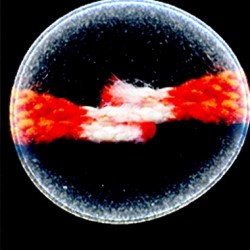 Cell Cycle: how chromosomes are separated for cell division
Cell Cycle: how chromosomes are separated for cell division
DNA makes RNA makes protein is a rule central to biology. The assemblage of molecular components like proteins [biological machines that carry out specific tasks in the cell] is incredible enough. But when the entire cellular factory is called upon to build another cell, thousands of molecular components must be fabricated. The continued birth of these kernels of biological industry is nothing short of astounding. Recent findings by the CSC Cell Cycle group (led by Luis Aragon) go some way to explaining part of the process. The team show how, under certain circumstances, telomeres [the ‘shoelace ends’ of chromosomes] become physically separated after DNA replication. This allows the chromosomes to move apart so the cell can complete its cycle of division.
Telomeres are like shoelace ends from a structural perspective though mechanistically they’re somewhat less mundane: acting as buffers for the transcriptional enzymes that read their DNA. They actually stop those enzymes falling off too soon, helping to ensure that all the important bits of DNA are read. And this special role in DNA replication may point to their fundamental involvement in such mysteries as ageing; see At a Loose End in the box below.
Luis and his group describe in Nature Cell Biology how Cdc14 [enzyme] helps most telomeres to separate in yeast. Yeast as a model organism tells us a lot about fundamental biological processes in humans. The group previously reported (Nature 2008) that Cdc14 inhibits RNA Pol I [ribosomal RNA-making enzyme]. Its action in this context stops transcription at the ribosome [protein factory] and allows chromosomes to condense so the cell can divide. Their recent findings show Cdc14 also targets RNAP-II [messenger RNA-making enzyme]. This enzyme fabricates messenger RNA strands, which when dispatched to the ribosome tell it what protein to make.
Luis explains: “We thought Cdc14 might promote telomere separation by interfering with RNAP-II at sites right next to the telomeres. When first found, Cdc14 was as part of a trio of proteins in a protein complex called RENT, which inhibits RNAP-II transcription of non-coding DNA between ribosomal genes. The two other subunits of the complex were shown to individually regulate RNAP-II activity, but no-one knew if Cdc14 did. We were able to determine that Cdc14 dephosphorylates two specific serine amino acids in the heptapeptide repeat of the C-terminal region in the main subunit of RNAP-II. So we know Cdc14 regulates RNAP-II.”
At a Loose End
Every time DNA replicates, less and less of the telomere is copied, because its function is to act as a buffer. This slow but relentless degradation continues until the telomere is too short to allow complete DNA replication. Steady telomere shortening is inextricably linked to ageing and to senescence, the cellular barrier to tumour development; greatly shortened telomeres are often observed in cancerous cells. The fact that telomeres are there on the ends of chromosomes helps to distinguish them from breaks in DNA that form during normal cellular processes; marking those ends as belonging to their separate chromosomes and preventing them being joined together by overzealous repair enzymes.
So the group wondered if this activity might extend to telomeres. Using yeast mutants for Cdc14, they confirmed their theory, although it only acts on telomeres that contain sub-telomeric Y’ elements, accounting for two-thirds of yeast telomeres. Physically, Cdc14 mutants couldn’t separate their telomeres, although the team had to find out why.
“So we used a drug to inhibit RNAP-II,” explains Luis, “and this resulted in greater separation of telomeres in the mutants. This evidence strongly suggests that Cdc14 inhibits RNAP-II transcription. We think this allows the loading of factors that change chromosome shape during mitosis, allowing them to separate.” This is the first time that Cdc14 – a protein phosphatase and transcription inhibitor – has been shown to play a role in telomere separation.
Cdc14 is differentially expressed in human cancer cells. In fact the group has already confirmed that human version Cdc14 also inhibits RNAP-II acting through the same molecular switches as in yeast. This means the finding is of medical significance.
SJ
This work was published in Nature Cell Biology:
Clemente-Blanco A, Sen N, Mayan-Santos M, Sacristán MP, Graham B, Jarmuz A, Giess A, Webb E, Game L, Eick D, Bueno A, Merkenschlager M, Aragón L. (2011) Cdc14 phosphatase promotes segregation of telomeres through repression of RNA polymerase II transcription. Nat Cell Biol, in press. doi: 10.1038/ncb2365.
